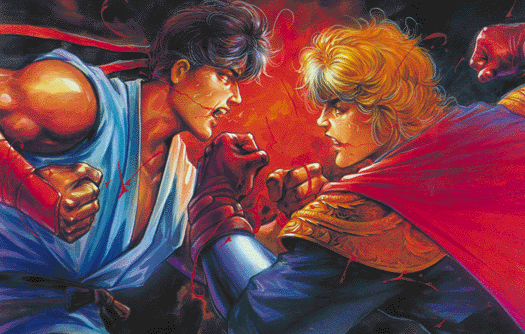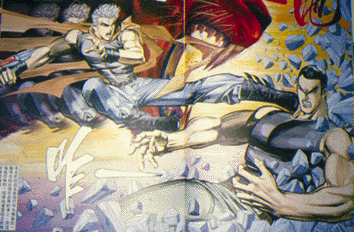A comic artist’s view on violenceBy Carol Ko Although only 19 years of age, Mr. Lung has been an assistant artist at Ocean Creative for 3 years. The characters he draws are all muscle-bound, kung fu style warriors or fighters. He provides insight into his profession, and the role of violence in comics, in the following interview. Q: Did anyone oppose your being a comic artist at such a young age. A: No, not at all. My parents were glad to see me find a job. Q: What is your job scope as an assistant artist?
A: We follow a precise division of labour process. The production of a comic book requires team work. I am responsible for the drawing of characters’ faces, but the different posts are interchangeable. The different jobs include outlining of a story, application of dialogues, the first actual drawing of characters and scenes in black and white, colouring and so on. Q: How many years does it take to become the chief artist? A: Well, this depends on the person’s talent. Any talented artist, no matter how long they have been working, can become the chief. Of course, they have to grasp the chance when there is one. Q: What is the target audience of local comics? A: Adults. We do not target our work to a specific sex, but our readers mostly labour process. The production of a comic book requires team work. I am responsible for the drawing of characters’ faces, but the different posts are interchangeable. The different jobs include outlining of a story, application of dialogues, the first actual drawing of characters and scenes in black and white, colouring and so on. Q: How many years does it take to become the chief artist? A: Well, this depends on the person’s talent. Any talented artist, no matter how long they have been working, can become the chief. Of course, they have to grasp the chance when there is one. Q: What is the target audience of local comics? A: Adults. We do not target our work to a specific sex, but our readers mostly come from the male group. Q: What are the main themes used in local comics? A: Well, there are many, such as ghost stories, fighting stories, love stories, science fiction, realistic stories, and the portrayal of triad societies. But nearly 50 percent of local comics involve violence.
Q: In your perspectives, why are violent factors used that heavily in local comic series? A: I guess that the use of the term “violent” is not appropriate. I mean that local comics can be used to express anything which does not happen in real life. For example, a man can break a rock with his head and punch through a stomach with his hand. That may be better phrased as imagination, rather than violence. Q: What is your overall impression of local comics? A: Readers read them for entertainment and throw them away afterwards, while some treasure them dearly. But to me, I’m involved in the production of each and every panel, in terms of time and dedication. Some do appreciate our work, while others merely see them as bloody fighting and killing. Some parents forbid their children from reading without any substantial reason at all. This is art which is not produced in a second. It requires many years of experience to achieve such a standard. Q: What are the key elements of a comic book’s success? A: Beautiful drawings and good stories are especially important. The development has to be logical. Sometimes the drawings are exaggerated, such as the portrayal of a man of 7 to 8 feet tall. But still, it depends much on readers’ acceptability, which varies among individuals. Q: Do you find it boring having been drawing for 3 years? A: Yes, of course. You get bored as well if you have read comics for such a long time. Q: What keeps you on, doing this job? A: Firstly, this is my job — and secondly, drawing is my interest. Q: What is your greatest satisfaction in your work? A: I only felt satisfied at the very beginning. At that time, I felt like publishing my own work. But that feeling did not last long. Q: What is your biggest difficulty? A: Competition. There are many artists competing for one post. Q: What can you do then? A: There’s not much I can do, except for doing well on my own part. Q: Is the job mobility high or low in this field? A: It depends on the individual. The working duration varies from 10 days to 20 years. Q: What is the proportion of female artists in this field? A: The ratio is about 1 to 10, but girls and boys are treated equally. Girls’ drawings tend to be less forceful and cartoon-like. |

